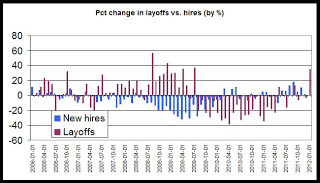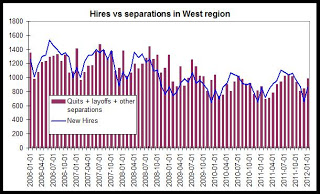According to the latest Job Openings and Labor Turnover report (JOLTS), released Tuesday by the U.S. Bureau of Labor Statistics, the West reported a decline in new hires, but the nation overall showed a 5 percent increase in new hires, when compared year over year. During the same period, layoffs fell 3.06 percent in the nation overall, although they increased significantly in the West region. (See Table 9 of the report.)
In the West region, with an increase of 34 percent, the year-over-year change in the layoffs in January showed the largest increase since 2009, while the year-over-year decline of 0.1 percent in new hires was the largest year-over-year decrease in hires reported since May 2011.
The first graph shows the year-over-year change in new hires and in layoffs in the U.S. West region.

In the second graph, we see the total number of new hires compared with the total number of separations, including quits, layoffs and other separations.
Note that when total hires (the blue line) are above total separations (the purple bar) then a positive net number of jobs have been added to the economy. January 2012 was the second month in a row during which separations have exceeded new hires in the West region.
For the West region during January 2012, there were 129,000 more separations than hires in the region. This is significantly larger than January 2011 when there were 14,000 more separations than hires.

According to Colorado's jobs report for January 2012, January was a productive month for job growth, although the rate of growth was less robust than previous months, when compared year over year, See here for more.
This report suggests some weakness in the job market, although the state employment report, based on the Household Survey, suggests more strength in job creation. Why the difference? The JOLTS report is a completely different set of data than the Household Survey, and is tied to the separate Establishment Survey, which may explain some of the difference. Also, while the Household Survey did show ongoing job creation, it did nevertheless show less strength in job creation in January than during November or December. In addition, the JOLTS report only extends down to the regional level.
Nevertheless, this report shows two month sin a row of fewer hires than separations. This employment data is tied to the Establishment Survey which does not cover small business hiring and self-employed persons. The less robust job growth shown in this report versus the State's report based on the Household Survey suggests that the job growth that is taking place is being created through self employment and small organizations.
Note: The BLS recent made some significant revisions to employment data. This analysis reflects the new revised data.